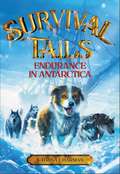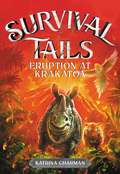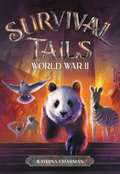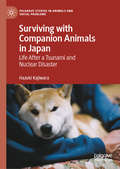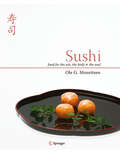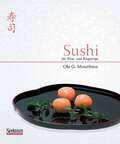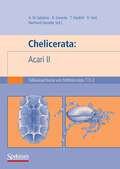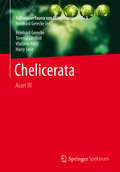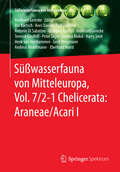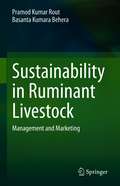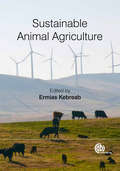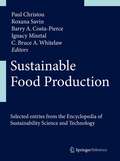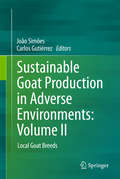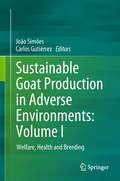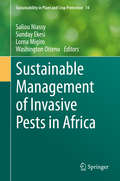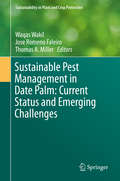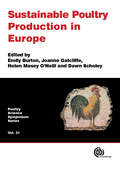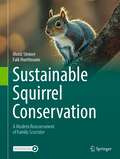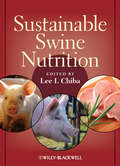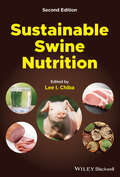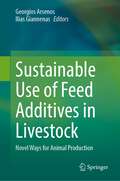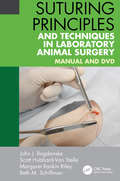- Table View
- List View
Survival Tails: Endurance in Antarctica (Survival Tails #2)
by Katrina CharmanA group of sled dogs race to survive a perilous journey across Antarctica in the exhilarating second installment of Survival Tails, perfect for fans of the Ranger in Time and I Survived series! Sled dog Samson wants nothing more than to be part of Ernest Shackleton's historic voyage to Antarctica. He wants to feel the snow under his paws and the wind on his face as he races across the ice fields, and most of all he wants to help his humans find eternal glory as they chart the continent. His fellow sled dog, Bummer, just wants to get through the voyage in one piece. Why would he want to face down a dangerous, icy wasteland when he could stay inside his kennel, warm and safe?When their ship, the Endurance, becomes trapped in sea ice, leaving the dogs and men with no way home, their journey becomes not about personal glory, but about survival. Samson, Bummer, and the other dogs will have to put aside their differences and band together to rescue their humans...and themselves.With engaging nonfiction back matter that delves into the fascinating true story behind the book, Survival Tails: Endurance in Antarctica is sure to keep readers entertained as the second entry in this series of action-packed animal adventures.
Survival Tails: Eruption at Krakatoa (Survival Tails #4)
by Katrina CharmanAnimals must team up to survive the catastrophic eruption of Krakatoa in this heart-pounding fourth installment of Survival Tails, perfect for fans of the Ranger in Time and I Survived series.Parakeet Melati lives with the rest of her bird friends and family on the beautiful slopes of the Indonesian island of Krakatoa. While rumblings sometimes sound from deep within the earth, the birds live peacefully in their jungle. But when Melati is woken by tremors stronger than she's ever felt before, she realizes that her sleeping island volcano may not be sleeping any longer.Across a narrow stretch of water lives Budi, a rhinoceros, and his old friend Raja, the tiger king of the jungle. When Melati arrives with a dire warning that something is happening to Krakatoa, Raja believes the animals are safest in the jungle, but Budi disagrees. As ash rains down on the island and the earthquakes worsen, Raja must put aside his fears and put his trust in Budi. Otherwise, the animals of the jungle will never stand a chance against the mighty eruption of Krakatoa.With lush black-and-white illustrations and bonus facts that delve into the fascinating true story behind the eruption, Survival Tails: The Eruption of Krakatoa will both captivate and educate young readers.
Survival Tails: World War II (Survival Tails #3)
by Katrina CharmanA brave messenger pigeon enlists a group of heroic zoo animals to help him complete his mission in this thrilling, informative read, perfect for fans of the Ranger in Time and I Survived seriesWorld War II is raging across Europe and the German army has their sights set on England. Messenger pigeon Francis carries important notes back and forth between England and her allies, and wants nothing more than to do his part for the war effort. But when Francis is injured on an assignment to deliver the most important message of the war--one which warns of a coming attack on Britain itself--he finds himself stranded in the middle of the London Zoo with no way to complete his mission.Ming, the world-famous panda, has so far managed to avoid being caught up in the war. But that's getting harder and harder to do as the zoo suffers under dwindling food rations and German air raids threaten the city every night. When Francis lands in Ming's enclosure, she knows she can no longer stand by and do nothing. Enlisting the help of a kind zookeeper and a resourceful troop of monkeys, Ming fights to help Francis recover his strength so that he can carry out his mission.But when the war finally arrives in London, threatening everyone in the zoo, Francis, Ming, and the other animals must work together to save themselves...and maybe even London itself.
Surviving with Companion Animals in Japan: Life after a Tsunami and Nuclear Disaster (Palgrave Studies in Animals and Social Problems)
by Hazuki KajiwaraThis book examines how relationships between guardians and companion animals were challenged during a large-scale disaster: the tsunami of March 2011 and the following nuclear disaster in Fukushima. The author interrogates: 1) How did guardians and their companion animals survive the large disaster?; 2) Why was the relationship between guardians and their companion animals ignored during and after a disaster?; and 3) What structures and/or mechanisms shaped the outcomes for animals and their guardians? Through a critical realist framework, combined with a theoretical perspective developed by Roy Bhaskar and his colleagues, the author argues that despite the trivialization of companion animals by government officials, relationships between animals and guardians were often able to be maintained, in some cases through great pains by the guardians. While the notion of human-animal relationships in Japan has thus far been dominated by economic logic, the author reveals dynamics between guardians and companion animal transcend such structures, forging the concept of “bonding rights.”
Sushi: Food for the Eye, the Body and the Soul
by Ole G. Mouritsen"It is clear that serious research, as well as much imagination, went into every page. It has become my new ‘go-to’ bible when I need a shot of inspiration."Ken Oringer, internationally renowned and award-winning chefClio Restaurant, Uni Sashimi Bar, Boston"Congratulations on writing such an aesthetically beautiful, informative and inspiring book. ... I shall not hesitate to recommend your book to those colleagues, who like me, are fascinated by Sushi and who will surely be captivated, like me, turning every page."Dr. Ian C. Forster, April, 2011• • •In recent decades, sushi has gone from being a rather exotic dish, eaten by relatively few outside of Japan, to a regular meal for many across the world. It is quickly gathering the attention of chefs and nutritionists everywhere. It has even made its way into numerous home kitchens where people have patiently honed the specialized craft required to prepare it. Few have been more attuned to this remarkable transition than Ole G. Mouritsen, an esteemed Danish scientist and amateur chef who has had a lifelong fascination with sushi’s central role in Japanese culinary culture. Sushi for the eye, the body, and the soul is a unique melange of a book. In it, Mouritsen discusses the cultural history of sushi then uses his scientific prowess to deconstruct and explain the complex chemistry of its many subtle and sharp taste sensations. He also offers insights from years of honing his own craft as a sushi chef, detailing how to choose and prepare raw ingredients, how to decide which tools and techniques to use, and how to arrange and present various dishes.Sushi is irresistible for both its simplicity and the hypnotic performance-art aspects that go into its preparation. With clear prose and straightforward instructions, Mouritsen looks at every facet of sushi in a book that is as accessible as it is informative, as useful as it is fun.
Sushi: Für Wiss- und Bissgierige
by Ole G. MouritsenIn den vergangenen Jahrzehnten hat sich Sushi von einer eher exotischen Speise hin zu einer weltweit bekannten Speise entwickelt. Der Däne Ole G. Mouritsen hat sich über viele Jahre sich als Wissenschaftler und Hobbykoch ein ungeheures Wissen über Sushi angeeignet, deren interessanteste und faszinierendste Facetten er in diesem Buch zusammengetragen hat. Das Buch ist eine einzigartige Mischung aus Kultur und Geschichte, Chemie und Sensorik, Lebensmittelkunde und Rezepten. Mouritsen kombiniert in diesem Buch die Faszination des Fremden mit einfachen Rezepten für die Zubereitung; Prosa und wissenschaftliche Darstellung vereinen sich in diesem ungewöhnlichen Werk, so dass Sie beim Schmökern sicherlich Lust auf sofortigen Sushi-Genuss bekommen.
Süßwasserfauna von Mitteleuropa, Bd. 7/2-2 Chelicerata: Acari 2 (Süßwasserfauna von Mitteleuropa)
Chelicerata are a basically terrestrial group of invertebrates, including many clades whose representatives have never found an evolutionary way to aquatic live. An exception is made by some spiders and the highly diverse aquatic mites which in inland water habitats are represented by members of numerous different clades having evolved an aquatic or amphibious lifestyle along various evolutionary pathways. For the first time in limnofaunistic bibliography, the present taxonomic knowledge about these different groups of invertebrates is brought together in an overview for the Central-European fauna. This second volume includes taxonomic keys and ecological information for the two species-rich superfamilies Hydryphantoidea and Lebertioidea of the freshwater mites (Hydrachnidia). A further volume in preparation will include the remaining two superfamilies, Hygrobatoidea and Arrenuroidea. The chelicerata volumes of this series are a basic tool for all limnologists interested in diversity and ecology - in particular for biologists investigating the ecotones between ground- and surface water, between benthos and plankton, and between water and land.
Süßwasserfauna von Mitteleuropa, Bd. 7/2-3 Chelicerata: Acari III (Süßwasserfauna von Mitteleuropa)
by Reinhard Gerecke Terence Gledhill Vladimir Pešić Harry SmitFor the first time in limnofaunistic bibliography, the present taxonomic knowledge about the different clades of chelicerata having adapted to an aquatic or amphibious lifestyle along various evolutionary pathways is brought together in an overview for the Central-European fauna. A total number of 746 taxa is covered, over 99 % of these at species level.In Volume 7/2-1 altogether 211 species are treated - 70 species of spiders, 7 species of Astigmata (3 of which to be identified only at family, genus, resp. species group level), 17 species of Oribatida, 27 species and one subspecies of Halacaridae, 45 species of terrestrial Parasitengona (4 of which to be identified only at genus level) and 45 species of Hydrachnidia (4 Stygothrombioidea, 3 Hydrovolzioidea, 16 Hydrachnoidea and 22 Eylaoidea). Volume 7/2-2 deals with 179 species of Hydrachnidia (58 Hydryphantoidea and 121 Lebertioidea).This third volume (Volume 7/2-3) includes taxonomic keys and ecological information for 355 species of the two highly diverse Hydrachnidia superfamilies Hygrobatoidea (241 species and one subspecies) and Arrenuroidea (113 species).The chelicerata volumes of this series are a basic tool for all limnologists interested in diversity and ecology – in particular for biologists investigating the ecotones between ground and surface water, between bottom substrata and open water, and between water and land.
Süßwasserfauna von Mitteleuropa, Vol. 7/2-1 Chelicerata: Araneae/Acari I (Süßwasserfauna von Mitteleuropa)
by Ilse Bartsch Kees Davids Ralf Deichsel Antonio Di Sabatino Grzegorz Gabrys Terence Gledhill Peter Jäger Joanna Makol Harry Smit Henk van der Hammen Gerd Weigmann Andreas Wohltmann Eberhard WurstChelicerata are a basically terrestrial group of invertebrates, including many clades whose representatives have never found an evolutionary way to aquatic live. An exception is made by the spiders, which include a considerable number of hygrophilous species, and by the highly diverse aquatic mites which in inland water habitats are represented by members of numerous different clades having evolved an aquatic or amphibious lifestyle. For the first time the present taxonomic knowledge about these different groups of invertebrates is brought together in an overview for the Central-European fauna. This volume includes taxonomic keys and ecological information concerning hygrophilous and aquatic spiders, a general introduction to mites, and the treatment of three mite groups generally known from terrestrial habitats. Also, the freshwater-dwelling representatives of the originally marine Halacaridae are treated, and the species-rich true freshwater mites (Hydrachnidia) are represented in a general overview.
Sustainability in Ruminant Livestock: Management and Marketing
by Pramod Kumar Rout Basanta Kumara BeheraThis book presents a concept for implementing a mass balance approach toward developing an effective eco-friendly, livestock farming system independent of external energy input. In this context it describes a modern, integrated farming system, and includes comprehensive technical information explaining the design and evaluation of manure management systems, and modeling and operational tools. It first discusses the mass balance operating process, highlighting the difference between imported and exported mass across the farm boundary. Estimating mass balance can provide critical information for (comprehensive) nutrient management planning and for managing the movement of nutrients and manure. It then explains the estimation of whole-farm P mass balance using a suitable model system. The subsequent chapters provide updated information on management aspects of livestock-farming and generation of multiple job opportunities, and also explore various aspects of livestock farming operational protocols like housing and management; nurture of rams, ewes and lambs, new born calves and heifers; care of buck, doe and kid- nutrition flushing; concept zero grazing-systems; disease control and management; integrated goat farming; and crop-livestock integration. Further, the book addresses crop-livestock integration; energy autonomy in cattle farming; value added biopharmaceuticals from cattle farming; CAPEX for cattle farming; concepts of cattle farming; detrimental effects of the industry; topographic and edaphic factors, and thermal stress on livestock growth and development; socioeconomic development; and water requirements for livestock. The book concludes with the most important issue in the field of agriculture and veterinary science: “Livestock Farming with Care,” describing sustainable, eco-friendly livestock farming by highlighting issues like animal feed vs. human food; agricultural GDP vs livestock, and factors affecting the sustainability of livestock farming. Given its scope, this book is a valuable resource for researchers and students alike, and will also appeal to practitioners in the field of livestock.
Sustainable Animal Agriculture
by Ermias KebreabIn order to meet increasing global demand for meat and animal by-products increasingly intensive animal production is necessary. Creating a sustainable system in animal agriculture that works in different production environments is a major challenge for animal scientists. This book draws together themes on sustainability that have emerged as the most pressing in recent years. Addressing practical topics such as air quality, manure management, animal feeds, production efficiency, environmental sustainability, biotechnology issues, animal welfare concerns, societal impacts and an analysis of the data used to assess the economic sustainability of farms.
Sustainable Food Production
by Paul Christou, Roxana Savin, Barry A. Costa-Pierce, Ignacy Misztal and C. Bruce A. WhitelawSustainable Goat Production in Adverse Environments: Local Goat Breeds
by João Simões Carlos GutiérrezThis book covers more than 40 indigenous goat breeds and several ecotypes around the globe and describes genotypic and phenotype traits related to species adaptation to harsh environments and climate change. It also addresses sustainable global farming of local goat breeds in different production systems and agro-ecosystems. Discussing three main global regions: Asia, Africa, and Europe, it particularly focuses on adverse environments such as mountain, semiarid and arid regions. The topic of this highly readable book includes the disciplines of animal physiology, breeding, sustainable agriculture, biodiversity and veterinary science, and as such it provides valuable information for academics, practitioners, and general readers with an interest in those fields.
Sustainable Goat Production in Adverse Environments: Welfare, Health and Breeding
by João Simões Carlos GutiérrezThis book explores the current trends and challenges of sustainable goat meat and milk production in different global contexts, providing valuable insights into this industry in adverse environments like mountain, semiarid and arid regions. It also includes contributions from international experts discussing goat reproduction, genetic diversity and improvement, as well topics such as animal health, welfare, socioeconomic aspects, and many other issues regarding the environmentally friendly and economically viable exploitation of goats. This is a highly informative book providing scientific insight for readers with an interest in sustainable agriculture and socio-economic aspects, as well as goat breed conservation, genetic diversity, and veterinary care. These subjects are complemented in a second volume providing a detailed description of more than 40 indigenous goat breeds and several ecotypes found in Asia, Africa, Europe, and America.
Sustainable Management of Invasive Pests in Africa (Sustainability in Plant and Crop Protection #14)
by Saliou Niassy Sunday Ekesi Lorna Migiro Washington OtienoInvasive species, generally, affect economically important crops, thus affecting the livelihoods of millions of people along crop value chains. Typically, invasive species have high migratory capabilities and, because of plant material exchanges made during trade, they cannot be contained by one country. Usually, African countries react after a pest has invaded and established itself in the country, making the cost of mitigating the pest even more expensive. This book presents a pan-African view of the impacts of invasive insect pests on agriculture and of how invasive species impact on productivity in Africa. It not only describes their importance, but also presents a diversity of research findings in the field, ranging from the use of early warning and monitoring systems for quarantine purposes, agricultural extension, all the way to control strategies. The IPM arsenal presented in this book includes the use of botanical bioactive compounds, semiochemicals, resistant varieties, biological control agents such as entomopathogens, endophytes, predators, and natural enemies. Aspects of technology transfer strategies, regional coordination, and farmers’ perceptions have not been overlooked, because these affect the adoption of mitigation strategies. The book also presents measures that would help agricultural research services to estimate the damage and take actions for preparedness and readiness to face invasive insect pests. This starts with a basic knowledge of taxonomy to enable concerned persons to describe the insects and the vast inventory of affected crops. Physiological and ecological aspects of invasive pests are strongly highlighted to strengthen Integrated Pest Management Strategies. The threat of invasive species will remain permanent; therefore, the book encourages knowledge exchange and collaboration between researchers and scientists on the continent, while encouraging the establishment of a platform or a fund for preparedness and rapid response.
Sustainable Pest Management in Date Palm: Current Status and Emerging Challenges (Sustainability in Plant and Crop Protection)
by Waqas Wakil Jose Romeno Faleiro Thomas A. MillerDate palm, Phoenix dactylifera L. (Arecales: Arecaceae), is an important palm species cultivated in the arid regions of the world since pre-historic times and traditionally associated with the life and culture of the people in the Middle-East and North Africa which are the pre-dominant date palm growing regions worldwide. The Food and Agriculture Organization of the UN estimates that there are over 100 million date palms with an annual production of over 7.5 million tonnes A recent report on the arthropod fauna of date palm, enlists 112 species of insects and mites associated with date palm worldwide including 22 species attacking stored dates. Enhanced monoculture of date palm in several date palm growing countries coupled with climate change, unrestrained use of chemical insecticides and extensive international trade is likely to impact the pest complex and the related natural enemies in the date agro-ecosystems. In view of the importance of date palm as an emerging crop of the future and the need to develop and deploy ecologically sound and socially acceptable IPM techniques, this book aims to comprehensively address issues related to the biology and sustainable management of major insect and mite pests of date palm by assessing the current IPM strategies available, besides addressing emerging challenges and future research priorities. The issues pertaining to the role of semiochemicals in date palm IPM involving new strategies revolving around “attract and kill” and “push-pull” technologies, phytoplasmas and their insect vectors with implications for date palm, innovative methods for managing storage pests of dates and knowledge gaps in devicing sustainable strategies for the management of red palm weevil, Rhynchophorus ferrugineus (Olivier) are also addressed
Sustainable Poultry Production in Europe (Poultry Science Symposium Series)
by Anne-Marie Neeteson Patricia Parrott Nan-Dirk Mulder Richard Kempsey Robby Andersson Piet Van der Aar Brett Roosendaal Patrick Wall Andrew Walker Steve Pritchard William G. Hill Mike McGrew Adrian Williams Colin FisherExamining sustainable poultry production systems across Europe, this book contains a selected cross section of papers from the 2014 UK Poultry Science Symposium. It reviews essential topics such as resources and supply chains, the global poultry market, risk management, zoonoses and green issues. Providing a compilation of the most current research in the poultry science and production industry, this book is an important resource for both researchers and professionals.
Sustainable Squirrel Conservation: A Modern Reassessment of Family Sciuridae
by Moriz Steiner Falk HuettmannThis book attempts to move the family of squirrels (Sciuridae) out of the shadow of large charismatic mammals and to highlight management failures with the goal of moving towards an improved conservation approach. Particular attention is paid to the influence of taxonomic science on squirrel conservation. In addition, the authors show how human-driven climate change, global change and modern politics are shaping global squirrel populations as well as their surrounding environments and ecosystems.Squirrels are widespread around the globe, naturally occurring on every continent except Antarctica and Oceania, and they are certainly among the animals most commonly encountered in everyday life. Despite this, the authors of this volume identify worrying gaps in squirrel conservation. Squirrels are often hunted, trapped, poached, and stressed, and management strategies and legislation are often devised in the absence of proper knowledge of issues such as population sizes, taxonomies, and trends. Together, this can result in severe population declines and even species extinction. By assessing their taxonomic situation, ecology, the evolution and divergence of Sciuridae around the globe, and squirrels’ well-being across habitats, the authors set a baseline from which to launch future investigations into the conservation of squirrels and other species. Additionally, the authors highlight the influences of climate change, unsustainable growth, and various man-made threats to the future of this family.
Sustainable Swine Nutrition
by Lee I. ChibaFinding sustainable means of swine nutrition is important to both pork industry personnel and the environment alike. This reference comprehensively covers the most recent advancements in sustainability that results in more efficient diets, thus reducing both production costs and waste. Chapters include information on alternative feedstuffs, feed additives, bioavailabity of nutrients, and management of wastes and odors. Written by internationally recognized experts in the field, Sustainable Swine Nutrition will be a valuable reference for those involved in all aspects of pork production. Comprehensively covers the most recent advancements in sustainability to promote reduced pork production costs and waste Covers recent topics such as alternative feedstuffs, feed additives, and bioavalability Discusses environmental topics such as waste and odor management Written by an international team of experts in the field
Sustainable Swine Nutrition
by Lee I. ChibaFinding sustainable means of swine nutrition is important to both pork industry personnel and the environment alike. This reference comprehensively covers the most recent advancements in sustainability that results in more efficient diets, thus reducing both production costs and waste. Chapters include information on alternative feedstuffs, feed additives, bioavailabity of nutrients, and management of wastes and odors. Written by internationally recognized experts in the field, Sustainable Swine Nutrition will be a valuable reference for those involved in all aspects of pork production. Comprehensively covers the most recent advancements in sustainability to promote reduced pork production costs and waste Covers recent topics such as alternative feedstuffs, feed additives, and bioavalability Discusses environmental topics such as waste and odor management Written by an international team of experts in the field
Sustainable Swine Nutrition
by Lee I. ChibaSustainable Swine Nutrition As climate change continues to have a significant impact on the modern world, it is crucial to find alternative sources of energy and nutrients for swine production. The development of optimal feeding revolves around a multitude of considerations—genetic variations in the pig, variability, availability, and stability of nutrients in feed ingredients, interactions among nutrients and non-nutritive factors, voluntary feed intake, physical (& social) environment of pigs, and more. Establishing the ideal network of factors will only grow in importance as humans assess the methods for our own food networks. Sustainable Swine Nutrition is a comprehensive book on swine nutrition, covering some fundamental aspects of nutrition—namely digestive physiology, water, protein or amino acids, lipids, carbohydrates, energy metabolism, vitamins, minerals, and nutrition and immunology. Providing the most up-to-date information on each of these areas, a major emphasis of this second edition is on recent developments and current advances in the field, with a focus on pertinent issues linked with energy and nutrients. In doing so, the book highlights topics and issues that can contribute to the ultimate goal of successful and sustainable swine production. Sustainable Swine Nutrition readers will also find: Environmentally friendly, optimal feeding strategies for successful and sustainable swine production Recent developments, such as alternative feedstuffs, feed additives, and bioavailability Expanded treatment and new chapters on swine physiology, energy and protein, technology, and more Sustainable Swine Nutrition, Second Edition, is an ideal resource for livestock scientists and industry professionals involved in all aspects of pork production.
Sustainable Swine Nutrition
by Lee I. ChibaSustainable Swine Nutrition As climate change continues to have a significant impact on the modern world, it is crucial to find alternative sources of energy and nutrients for swine production. The development of optimal feeding revolves around a multitude of considerations—genetic variations in the pig, variability, availability, and stability of nutrients in feed ingredients, interactions among nutrients and non-nutritive factors, voluntary feed intake, physical (& social) environment of pigs, and more. Establishing the ideal network of factors will only grow in importance as humans assess the methods for our own food networks. Sustainable Swine Nutrition is a comprehensive book on swine nutrition, covering some fundamental aspects of nutrition—namely digestive physiology, water, protein or amino acids, lipids, carbohydrates, energy metabolism, vitamins, minerals, and nutrition and immunology. Providing the most up-to-date information on each of these areas, a major emphasis of this second edition is on recent developments and current advances in the field, with a focus on pertinent issues linked with energy and nutrients. In doing so, the book highlights topics and issues that can contribute to the ultimate goal of successful and sustainable swine production. Sustainable Swine Nutrition readers will also find: Environmentally friendly, optimal feeding strategies for successful and sustainable swine production Recent developments, such as alternative feedstuffs, feed additives, and bioavailability Expanded treatment and new chapters on swine physiology, energy and protein, technology, and more Sustainable Swine Nutrition, Second Edition, is an ideal resource for livestock scientists and industry professionals involved in all aspects of pork production.
Sustainable Use of Feed Additives in Livestock: Novel Ways for Animal Production
by Georgios Arsenos Ilias GiannenasThis book offers a comprehensive collection of cutting-edge research on feed additives for a sustainable animal production, including insects and aquaculture. In five clearly structured sections, the sources of feed additives, details on their biochemistry, feed security as well as specific applications for individual farm animal species, livestock health and product characteristics (meat, milk and eggs) find attention. International expert authors provide a full description on the use of aromatic plants, extracts and essential oils as feed additives alone or in combination with functional feeds of different categories. Readers will explore the potential of feed additives to tackle environmental issues. Practical examples include the use of local feedstuffs in combination with herbal additives and enzymes. Emphasis is placed on the consequences of using local feed sources versus imported feedstuffs on global warming potential, primary energy use, nutrient excretion and the feed additive influence on lessening the pollution from animal operations. The results presented will support realization of the Sustainable Development Goals, in particular SDG 12 which stands for Responsible Consumption and Production worldwide. The use of novel and different feed additives can be an important tool to enhance sustainability, support productivity, and match increased food demands around the globe. Animal production depends on feed efficiency to sustain growth and profitability. Along these lines, the present volume is an essential reading for all future-oriented veterinarians, animal nutritionists, agricultural scientists, and moreover the feed, food and plant industry.
Suturing Principles and Techniques in Laboratory Animal Surgery: Manual and DVD
by John J. BogdanskeSuturing Principles and Techniques in Laboratory Animal Surgery: Manual and DVD introduces the basic principles of, and the materials and instruments required for, suturing and wound closure on animals in a research or veterinary facility. The manual provides descriptions and pictures portraying proper tissue handling and aseptic technique during w
Suturing Principles and Techniques in Laboratory Animal Surgery: Manual and DVD
by John J. BogdanskeSuturing Principles and Techniques in Laboratory Animal Surgery: Manual and DVD introduces the basic principles of, and the materials and instruments required for, suturing and wound closure on animals in a research or veterinary facility. The manual provides descriptions and pictures portraying proper tissue handling and aseptic technique during w
